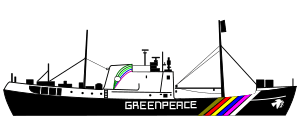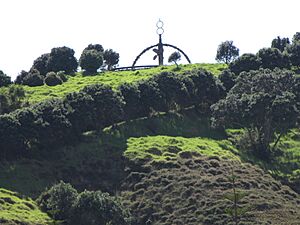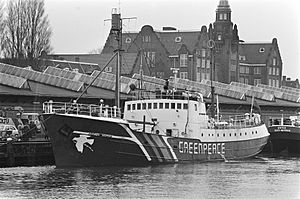Rainbow Warrior (1955) facts for kids

A vector drawing of Rainbow Warrior
|
|
| History | |
|---|---|
| Name |
|
| Owner |
|
| Operator | |
| Port of registry | Aberdeen, United Kingdom |
| Builder | Hall, Russell & Company, Aberdeen, UK |
| Yard number | 846 |
| Launched | 29 November 1954 |
| Acquired | 1977 |
| Identification | IMO number: 5329786 |
| Fate |
|
| General characteristics | |
| Class and type | Trawler |
| Tonnage | 418 GT |
| Length | 40 m (131 ft 3 in) |
| Draught | 4.6 m |
| Propulsion | 2 engines, 620 m² of sails |
| Speed |
|
The Rainbow Warrior was a famous Greenpeace ship. It played a big part in campaigns against whaling, seal hunting, and nuclear testing. It also protested against dumping nuclear waste.
On July 10, 1985, the French intelligence service (Direction Générale de la Sécurité Extérieure) attacked the Rainbow Warrior. They bombed the ship in the Port of Auckland, New Zealand. The ship sank, and a photographer named Fernando Pereira was killed.
Contents
The Ship's Early Life and Purpose
The Rainbow Warrior was first built in 1955. It was a trawler (a type of fishing boat). Its original name was Sir William Hardy. The UK Ministry of Agriculture, Fisheries and Food ordered its construction. It was built in Aberdeen, Scotland.
Joining Greenpeace and New Name
In 1977, the environmental organization Greenpeace bought the ship. They paid £37,000 for it. The ship then had a four-month makeover. On May 2, 1978, it was relaunched as the Rainbow Warrior.
Greenpeace co-founder Susi Newborn named the ship. She got the idea from a book called Warriors of the Rainbow. Another co-founder, Robert Hunter, had given her the book. The book talked about people rising up like "Warriors of the Rainbow" to help the world.
Campaigns and Journeys
The Rainbow Warrior took part in many important campaigns. It sailed in the North Atlantic. In 1981, the ship was changed to improve its design. In 1985, it got sails, becoming a ketch rig (a type of sailing ship).
In early 1985, the Rainbow Warrior was in the Pacific Ocean. It was campaigning against nuclear testing. In May, it helped move 300 Marshall Islanders. They were from Rongelap Atoll, which had been affected by radiation from past American nuclear tests.
The ship then traveled to New Zealand. It planned to lead a group of yachts. These yachts would protest against French nuclear tests. The tests were happening at the Moruroa Atoll in French Polynesia.
French agents secretly gathered information about the ship. One agent, Christine Cabon, worked in the Greenpeace office. Other agents pretended to be supporters or tourists. They toured the ship while it was open to the public.
The Attack on Rainbow Warrior
On July 10, 1985, just before midnight, the Rainbow Warrior was attacked. It was captained by Peter Willcox. Agents from the French intelligence service (DGSE) attached two bombs to the ship's hull.

The first bomb exploded. One person on board, photographer Fernando Pereira, went back to get his equipment. The second, larger explosion then sank the ship, and Fernando was killed.
Aftermath and Justice
Police started an investigation into the death. Two French agents were caught and arrested. When it was revealed that France was involved, it caused a big political problem. The French Minister of Defence, Charles Hernu, resigned.
The arrested French agents were sent to prison. Later, they were transferred to French custody. They stayed at a French military base for a short time before being released.
France faced pressure from other countries. They agreed to pay money to Greenpeace. Later, the former head of the DGSE admitted that three teams had carried out the bombings. The two divers who placed the bombs were Jacques Camurier and Alain Tonel. Their identities have never been officially confirmed.
On September 22, 1985, the French Prime Minister, Laurent Fabius, spoke to journalists. He said, "The truth is cruel," and admitted there had been a cover-up. He also said that "Agents of the French secret service sank this boat. They were acting on orders."
Greenpeace and France agreed to let an international group decide on the claims. This group ordered France to pay Greenpeace US$8.1 million. David McTaggart, Greenpeace's chairman, called it "a great victory." He said it was a victory for peaceful protest and against violence.
The Ship's Final Resting Place
The wreck of the Rainbow Warrior was brought to the surface on August 21, 1985. It was moved to a naval harbor for examination. The damage was too great to fix the ship.
So, on December 12, 1987, the ship was sunk again. This time, it was sunk on purpose in Matauri Bay in the Cavalli Islands, New Zealand. It became a dive wreck and an artificial reef. This helps marine life grow. The hull is now covered with many colorful sea anemones.
The ship's masts were saved. They now stand outside the Dargaville Museum. Greenpeace later got a second ship named Rainbow Warrior in 1989. A third ship with the same name was built in 2011.
Books About the Rainbow Warrior
Many books have been written about Greenpeace and the Rainbow Warrior.
- A Bonfire in my Mouth: Life, Passion and the Rainbow Warrior by Susi Newborn (2003).
- Greenpeace: An Insider's Account. How a Group of Ecologists, Journalists and Visionaries Changed the World by Rex Wyler (2004).
- From Deptford to Antarctica – The Long Way Home by Pete Wilkinson (2014).
Books about the bombing include Eyes of Fire: The Last Voyage of the Rainbow Warrior. This book was written by David Robie, who was on the ship.
French books also discuss the event. L'affaire Greenpeace by Jacques Derogy (1990) notes the incident cost France 115 million francs. It was also a major scandal during the Mitterrand presidency.
Images for kids
See also
 In Spanish: Rainbow Warrior para niños
In Spanish: Rainbow Warrior para niños




